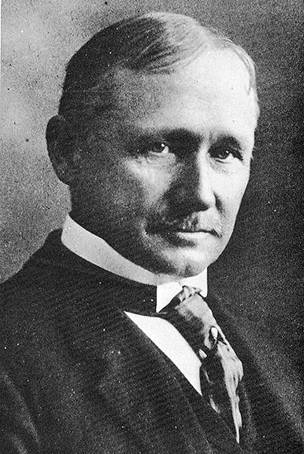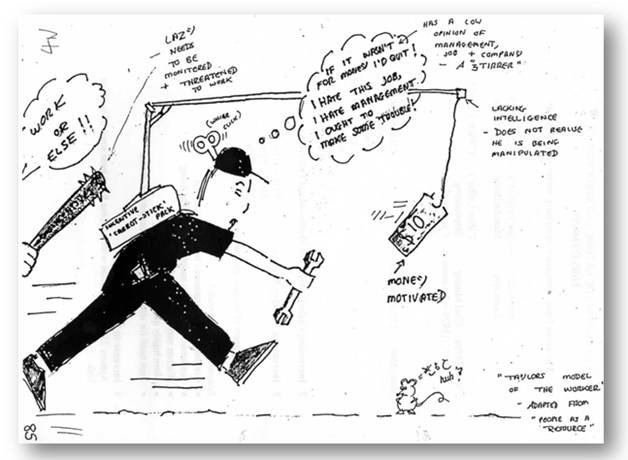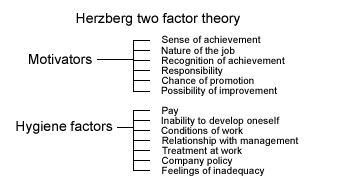Content theories

All men seek one goal; success of happiness. The only way to achieve true success is to express yourself completely in service to society. First have a definite, clear, practical ideal - a goal, an objective. Second have the necessary means to achieve your ends - wisdom, money, materials and methods. Third adjust your means to that end.
Aristotle 384 -322 B.C.
Content theories focus on what motivates people, namely a need that must be satisfied, which is either intrinsic or extrinsic.
Frederick Winslow Taylor: Scientific Management.
 The prosperity of a country depends upon its productivity; how it uses its manpower, land, machines, raw materials and other resource effectively. However, no one had considered analysing human beings at work until Frederick Winslow Taylor (1856 - 1917). Taylor was an American engineer who sought to improve industrial efficiency. He qualified as an engineer and his first attempt at reorganising management was at the Bethlehem Steel Company.
The prosperity of a country depends upon its productivity; how it uses its manpower, land, machines, raw materials and other resource effectively. However, no one had considered analysing human beings at work until Frederick Winslow Taylor (1856 - 1917). Taylor was an American engineer who sought to improve industrial efficiency. He qualified as an engineer and his first attempt at reorganising management was at the Bethlehem Steel Company.
Taylor's god was efficiency. Even as a young man he redesigned the tennis racket and used it to win the national championship. Taylor's seminal work, the Principles of Scientific Management was published six years before his death. In this publication he put forward his ideas of 'scientific management' (sometimes called 'Taylorism'). Scientific management means rigorous analysis of input, output and costs. It demands meticulous planning and systematic execution. There are four overriding principles to scientific management:
- Each part of a job should be analysed scientifically and the most efficient method of achieving it is devised
- The most suitable person to undertake the job is selected and is taught to do the job in the exact way devised
- Managers should cooperate with workers to ensure the job is done in a scientific way
- There is a clear 'division' of work and responsibility between management and workforce
Taylor equated men with machines, to be made efficient by removing unnecessary or wasted effort. He described workers as "machines with the shadowy entity of a mind attached". Machines work best when well-maintained and lubricated. Workers, therefore, should be provided with good working conditions and rewarded for higher performance. Reflecting the attitudes of his day, Taylor had a low opinion of the quality of the workers, believing they were inherently lazy and only motivated by money and greed.
Taylor's arguments began from his observation that, in general, workers in repetitive jobs work at the slowest rate that goes unpunished. He believed this slow rate of work (which he called "soldiering", but might nowadays be termed "loafing"), was a combination of the laziness of people and the observation that, when paid the same amount, workers will tend to do the amount of work of the slowest. He thought workers were innately unintelligent.
When one worker suggested changes to the pre-planned method of doing a job, Taylor told him that he was not asked to think, that there were others paid to do that work. As can be imagined, he was neither popular with workers, nor with other managers, who were threatened by his approach, as it challenged the way they managed.
He argued that a scientific approach to all work will improve efficiency. Taylorism is often mentioned along with Fordism, because it is associated with mass production methods and the division of labour in manufacturing factories. Scientific management relies upon time and motion study to find the "one best method" to achieve a goal, i.e., one that requires no unnecessary movements and that if it was taught to workers, productivity would increase. Taylor began the process by creating a control group and observing the behaviour of the group over an extended period.

Taylor's most famous use of scientific management took place at the Bethlehem Steel company. His first experiment involved the study of pig-iron handlers - men who carried iron around steel works and workers who shovelled coal. Taylor showed that the size of the shovel and the amount lifted affected the efficiency of workers. He went on to discover that there was an optimum load of 22 pounds per shovel that allowed workers to move the most tonnage per day. Taylor also arranged for there to be different sizes of shovel adapted to the different types of coal.
The result of his scientific approach at Bethlehem Steel was a reduction in the workforce from 600 to 140. The remaining labourers, however, were awarded a 60% increase in their wages. Later experiments involved bricklaying. He worked with an experienced bricklayer, Frank Gilbreth, to improve his efficiency. After 18 months of experimentation Gilbreth was able to lay a brick with five motions, instead of the original eighteen, by using such simple devices as building a platform to hold bricks at a height convenient to the bricklayer, instead of laying them on the ground. This was the beginning of time and motion study and formed the foundations of modern ergonomics.

Taylor introduced many concepts that were not widely accepted at the time. For example, he decided that the working day should include rest breaks so that the worker can recover from fatigue. Today's army uses it during forced marches - the soldiers are ordered to take a break of 10 minutes for every hour of marching. This allows for a much longer forced march than continuous walking.
Whilst Taylor's principles have logic and are still used today to improve efficiency, many strict applications of scientific management fail to account for two problems:
- individual differences: the most efficient way of working for one person may be inefficient for another
- the fact that the economic interests of workers and management are rarely identical, so that both the measurement processes and the retraining are opposed by the workforce.
Taylor's approach ignores the complications introduced because workers are necessarily human: personal needs, interpersonal difficulties, and the very real difficulties introduced by making jobs so efficient that workers have no time to relax. As a result, workers worked harder, but became dissatisfied with the work environment. Some have argued that this discounting of worker personalities led to the rise of trade unions.
Abraham Maslow: Hierarchy of Needs
Early classical management theorists such as Taylor saw humans as rational economic animals, motivated by extrinsic reward such as money. The rational approach, therefore, was to link reward to output. If the reward was increased, output would also increase. This simplistic view was challenged later by theorists who became classified as the Human Relations School.
Maslow was a social psychologist who was interested in the influences on human behaviour in the widest sense, not just in the work environment. His hypothesis was that unsatisfied needs act as motivators. He argued that humans are influenced by a series of needs, some biological and others less tangible. It must be remembered that for Maslow it is possible to satisfy needs both in the workplace and outside. This means that employers must have a holistic approach to motivation recognising that motivation may come from a satisfactory work/life balance.
If you would prefer to view this interaction in a new web window, then please follow the link below:

It is important to understand, therefore, that when one level of needs is satisfied then it no longer motivates. Firms will need to look at ways to satisfy higher level needs. So once pay is adequate, firms may examine improved social facilities.
However, Maslow's ideas have been criticised:
- Do all humans have the same needs?
- People often place different importance on different needs. Do people have different degrees of needs? Some will long for power; others for security. A good manager will recognise the differing needs of employees
- People move through the hierarchy at different rates
- It is possible to experience several needs together
- Money may be used to purchase higher order needs like ego possessions
- Can anybody's needs be fully satisfied? Should the top of the hierarchy be open, suggesting limitless desire for achievement?
Herzberg: Motivation-Hygiene or 'two factor' theory
Frederick Herzberg's celebrated theory was developed in his book Work and Nature of Man [1966]. Herzberg recognised Maslow's analysis and developed it further. His hypothesis is that removing factors causing dissatisfaction in the workplace, does not automatically cause satisfaction. He believes that employers need to seek out factors which positively increase satisfaction. His work developed out of research he conducted in the 1950s with two hundred engineers and accountants. He asked the two groups the simple question:
"Can you recollect occasions when you felt really happy in your work and what made you happy on these occasions?"
An analysis of their replies showed that their feelings or satisfaction had something to do with the work itself, such as times they solved problems or when their contribution was appreciated. Their satisfaction did not stem from extrinsic factors such as an increase in salary or promotion. These things were easily forgotten, but achievements in work remained. From his experiment, Herzberg postulated that humans have two sets of needs:
- Lower level needs as an animal to avoid pain and deprivation
- Higher level needs as a human being to grow psychologically
These needs have to be satisfied at work as much as in any other sphere of life.

Hygiene factors
Hygiene factors were identified by Frederick Herzberg as factors that can lead to workers being dissatisfied. He argued that firms needed to improve these hygiene factors to reduce dissatisfaction. Hygiene factors may include pay and conditions, company policy or the way people are treated at work. These satisfy the animal needs, but do not motivate.

Motivators
Motivators are factors, which help employees to gain job satisfaction, such as recognition of the job they are doing. An increase in motivators is required to improve job satisfaction. These factors satisfy the truly human or psychological needs.
As we can see from the two definitions above the first group of factors are hygiene factors, which focus on salary, security, working conditions and general company policy towards employees. Such conditions might remove dissatisfaction, but they will not improve staff morale and motivation.
The second group of factors is known as motivators or growth factors centre on recognition, responsibility, the nature of the work (e.g. health professionals) and opportunities for promotion. It is by improving these that motivation is increased.
These two factors are summarised in figure 2 below.

Figure 2 Herzberg two factor theory
The combination of hygiene and motivation factors can result in four conditions:
- High Hygiene / High Motivation: The ideal situation where employees are highly motivated and have few complaints.
- High Hygiene / Low Motivation: Employees have few complaints, but are not highly motivated.
- Low Hygiene / High Motivation: Employees are motivated but have many complaints. The job is exciting and challenging, but salaries and work conditions are not acceptable.
- Low Hygiene / Low Motivation: The worst situation where employees are unmotivated and have many complaints about their working conditions.
Herzberg replicated his findings in several other investigations in several countries, such as Japan and Russia. Most of Herzberg's research is uncontested in a general sense, but there is still debate on the role of salary, which appears to be in both groups. Herzberg placed it as a hygiene factor, however salary appears to be a short-term, but not long-term motivator.
Herzberg's work had an impact on reward systems with firms moving away from payment-by-results systems. As people work better when the work is intrinsically interesting, work should provide the opportunity for psychological growth. To improve performance, employers should provide the opportunity for job enrichment, job enlargement and job rotation - all concepts introduced by Herzberg.

It is of interest to note that Herzberg's motivators relate to the higher order needs of the individual representing the highest three levels in Maslow's hierarchy and hygiene factors (de-motivators), relate to Maslow's lower-order needs.
Douglas McGregor: Theory X and Theory Y
In 1960, Douglas McGregor published the Human Side of Enterprise. In this work he attempted to apply the implications of the work of Maslow, Taylor and Herzberg to what businesses do. He contrasted two sets of assumptions about employee's attitudes to work and responsibility. He argued that mangers fall into two categories: they are either Theory X or Theory Y.
Theory X
Theory X managers believe that employees are essentially lazy, work just for money and depict 'the economic man' characteristics of Taylor's scientific management. If this is the case then they need to be strictly controlled (using a more dictatorial or autocratic style of leadership). Theory X managers categorise employees as:
- Lazy and dislike work
- Motivated mainly by money
- Lacking ambition
- Selfish - their own needs are more important than those of the organisation
- In need of close control by management
McGregor feels that the Theory X approach is incorrect and misleading with negative consequences for the organisation. Acceptance of the Theory X view of workers leads to:
- Autocratic leadership
- Traditional tall organisation structures with narrow spans of control
- Centralisation of decision making
- Scientific management and standardisation
- A stress on extrinsic factors of motivation
Theory Y
In contrast to Theory X, Theory Y managers believe employees are motivated by the higher level needs on Maslow's hierarchy. They essentially enjoy work and are committed and enjoy responsibility. Theory Y managers categorise employees as:
- Well motivated and enjoy work
- Able to take responsibility and organise themselves
- Creative in the right working environment
- Independent and flexible
If managers accept Theory Y then this is likely to result in:
- More democratic leadership styles
- More flexible organisation structures
- A willingness to accept decentralised organisation and decision making
- A stress on intrinsic factors of motivation
 The motivation, the potential for development, the capacity to assume responsibility, the readiness to direct behaviours towards organizational goals, are all present in people. It is the responsibility of management to make it possible for people to reorganize and develop the human characteristics for themselves.
The motivation, the potential for development, the capacity to assume responsibility, the readiness to direct behaviours towards organizational goals, are all present in people. It is the responsibility of management to make it possible for people to reorganize and develop the human characteristics for themselves.
Douglas McGregor: The Human Side of Enterprise

Do not fall into the trap of stating that the Theory Y approach is a 'nicer' form of management and is 'softer' on employees. Theory Y is challenging because it expects every individual to do their best and take responsibility for their own performance and undertake new and varied tasks.

William Ouchi: Theory Z
Professor William Ouchi (1981) developed the concept of 'Theory Z', blending Japanese and American approaches to management. McGregor gave us Theory X and Theory Y. In Theory Z, Ouchi claims that it is irrelevant to classify people independent of their working environment. People change their priorities based on the situation in which they find themselves.
The central assumption of the theory is that workers should find the meaning of their lives in work. Corporations are the central unit of society and should take responsibility for employees' happiness. For employees, they wish their productive time to be rewarding and want to contribute to the success of whatever enterprise, which they may be associated. In practice, in the US, this approach translated into lots of benefits that allow workers to work longer hours!
